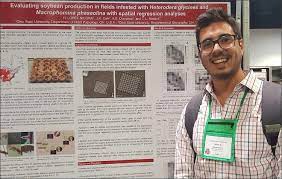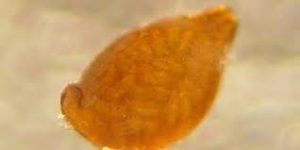How do Soybean Cysts Nematodes impact yield?
By Dusty Sonnenberg, CCA, Ohio Field Leader, a project of the Ohio Soybean Council and soybean check-off.
Each year Soybean Cyst Nematodes rob millions of dollars of income from soybean farmers due to lost yield. To add insult to injury, the impact to the crop cannot typically be seen until harvest. It is likely that above ground SNC stress symptoms may never be noticed. The best way to minimize SCN impact is by planting resistant varieties, or varieties with multiple resistances.
The SCN lifecycle is very interesting. “The nematode overwinters as eggs,” said Horacio Lopez Nicora, Assistant Professor in Plant Pathology at The Ohio State University. “It will remain in the soil enclosed in the SCN female nematode body (which we call a cyst) until it hatches into a second stage juvenile. That is the only infective stage of the entire life cycle of the nematode. It is the only stage that the nematode can penetrate into a root of a soybean plant.”

Nematodes can penetrate all soybean plants. “Nematodes can penetrate the roots of both susceptible and resistant varieties,” said Lopez-Nicora. “The resistance does not prevent the nematode from getting inside the root. The nematode will penetrate the root and migrate to the root’s vascular system. Once the nematode penetrates and gets to the vascular system, it will initiate a feeding site if the plant is susceptible. That feeding site will allow the nematode to continue to grow until the female nematode is ready to be fertilized by the male and then lay eggs every 24-40 days depending on the time of year. In the summer roughly every 25 days a generation is produced.”
This process is not completed on resistant varieties. “In a soybean plant with SCN resistance, the nematode will penetrate the root and migrate to the vascular system and attempt to initiate a feeding site. When the nematode initiates a feeding site it becomes sedentary. The nematode relies on the cells surrounding its head of the nematode to feed it,” said Lopez-Nicora. “In the SCN resistant soybean varieties the plant cells at the feeding site around the head of the nematode will die once the site is initiated and not feed the nematode to complete its life cycle.”
“I find this amazing,” said Lopez-Nicora. “Ever since I was young, I have always been fascinated by microscopic organisms and how they can impact our crops. It is like the resistant soybean plant is tricking the nematode and getting it inside to stop moving, and then it stops feeding it and it dies.”

There are different levels of resistance. “There is moderate resistance or highly resistant varieties. Resistance to SCN is quantitative,” said Lopez-Nicora. “We measure the level of SCN resistance of the variety by the ability of the nematode to reproduce on those roots.”
Plant appearance is not a sufficient measure to determine if SCN is a problem in a soybean field. “In our research, it is very consistent with research across the United States,” said Lopez-Nicora. “We are able to detect significant yield reduction between resistant versus susceptible lines without detecting any above ground visible symptoms. We have found yield reduction of 15-30%, all the way up to 50% yield reduction in SCN susceptible plants without any visible symptoms, including plant height and color. This makes it difficult to raise awareness. When we do find areas with visibly stressed plants and find areas on yield maps that show a reduction and go back and check for the presence of SCN in soil tests, we find SCN levels that are very high, and difficult to reduce.”